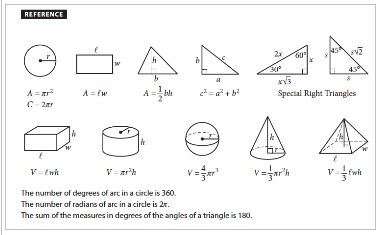The ACT recently announced it will start automatically approving accommodations that are already included in…
SAT or ACT? Part 2

Choosing between the SAT and the ACT: Quantitative (Math/Science) Considerations
Our Testing Strategist, Mr. Sean Quinn, shares his insights on the complexities of both the SAT and ACT so that you can make an informed decision about which is the best fit.
The Tests: Scoring Nuances
If you plan to apply to universities in the United States, you need to take one of two standardized tests: the SAT or the ACT. In this blog post, he will walk you through the major differences between the Quantitative portions of these exams and offer some advice that may help you decide which test is the better fit for you.
On the SAT, your Math score (on a scale of 200 to 800) is the sum of two subsections: SAT Math No Calculator and SAT Math with Calculator.
The No Calculator section gives you 25 minutes to complete 20 questions without the use of a calculator. The Calculator section gives you 55 minutes to complete 38 questions with the use of a calculator as needed.
On the ACT, by contrast, you receive a separate score on a scale of 1-36 for each of the Quantitative sections: one score for ACT Math and another for ACT Science.
The ACT Math section gives you 60 minutes to complete 60 questions with the use of a calculator as needed. The ACT Science section gives you 35 minutes to complete 40 questions; there may be a few small calculations, but calculators aren’t allowed.
If you’re wondering which test would be a better fit for you, your best bet is to take both an SAT diagnostic and an ACT diagnostic—before signing up for a tutoring program.
You may find you have a natural affinity for one test over the other, or you may discover you’re stronger in Verbal on one test and Math on another. Either way, these diagnostics provide useful data about where your strengths and struggles lie, and how you and your tutor can work together to maximize your overall score.
Key differences between SAT Math and ACT Math/Science
Nearly all universities in the United States accept both SAT and ACT scores and do not favor either test. While I can’t recommend one test over the other without seeing your diagnostic scores, I can point out a few key differences between the Quantitative sections of these exams that may influence which is the better fit for you.
1. Timing is significantly tighter on ACT Math and Science than on SAT Math
ACT Math and Science give students less time per question than does SAT Math. On ACT Math, you’ll have an average of 1 minute per question, and on ACT Science, you’ll have an average of 52.5 seconds per question. On SAT Math No Calc, you’ll have roughly 1 minute, 15 seconds per question, and on SAT Math with Calc, you’ll have roughly 1 minute, 26 seconds per question. Those extra seconds can make a big difference! If you struggle with timing on the Quantitative portion of the exam, the SAT may be a better fit for you—but keep in mind the following caveats:
First, as you’ll see below in Difference 2, just because the SAT Math passages allow more time per question, doesn’t mean they’re easier (in fact, the opposite is often true!).
Second, our tutors have loads of experience helping students test out different strategies that optimize both speed and accuracy. It’s very common for students to struggle with timing on the diagnostic exams, and we can help to troubleshoot that problem starting in the very first session. Put differently, struggling with timing on the diagnostic exam should not automatically rule out the ACT.
2. SAT allows more time per question, but questions are often longer and presented in trickier ways
In other words, you may be less crunched for time on the SAT than the ACT, but you may find that the SAT questions themselves are more difficult than the ACT questions. SAT Math places greater emphasis on word problems and data analysis than ACT Math does, and often those types of questions require not only more sophisticated math operations, but also stronger reading skills. Additionally, the SAT Math section includes longer questions—there are nearly 50% more words on the SAT Math sections than on ACT Math.
3. SAT Math includes a no-calculator-allowed section; ACT Math allows the use of a calculator throughout the whole math section
The ACT allows you to use a calculator on the entire Math section, while the SAT contains a no-calculator-allowed section. If you struggle to do calculations by hand or in your head, then you may prefer the ACT.
4. ACT includes a Science section; SAT does not
The ACT Science section is, in many ways, more of a critical reading section than a science section. Like ACT Reading, ACT Science presents you with a series of reading passages and asks questions that relate to those passages. ACT Science tests your ability to understand what you read, analyze what you see presented in charts and graphs, and make sense of summaries of research; it very rarely tests your prior knowledge of science facts and information (2-3 questions per section test basic outside science knowledge).
If you excel at the sciences (biology, chemistry, etc.) or reading—or a combination of the two—then the ACT Science section might play to your strengths. However, if science and/or reading are not your strong suit, then you may prefer the purely math-based quantitative portion of the SAT.
5. SAT provides you with a list of formulas on the test; ACT does not
At the top of the SAT Math sections you will see the following formulas:

You can refer to these at any time during the Math portions of the exam.
ACT Math, by contrast, does not supply you with these formulas, so you will need to memorize them and be able to utilize them on test day.
6: ACT Math covers a slightly greater range of topics than SAT Math does
ACT Math tests several math concepts that the SAT does not: for instance, matrices, graphs of trig functions, and logarithms.
7. Geometry features more prominently on ACT Math than on SAT Math
Both ACT Math and SAT Math place a strong emphasis on Algebra, but ACT Math also devotes a big chunk of the section – upwards of 30-45% – geometry. On SAT Math, geometry accounts for only about 10% of the questions. Likewise, trigonometry makes up slightly more of ACT Math (about 7%) than it does SAT Math (less than 5%).
If you’re a geometry and trigonometry superstar, you may prefer the ACT. If algebra and data analysis are more up your alley, then you might prefer the SAT.
8. SAT Math has some grid-in free-response problems (where you come up with your own answer); ACT Math only has multiple choice
Grid-in responses, where you pencil in your own answer rather than selecting from multiple choice answers, account for about 20% of the SAT Math questions. It’s very difficult to guess on these types of questions, or to catch a small mistake. If you prefer to choose from multiple choice answers, you may prefer the ACT.
9. ACT Math multiple choice gives 5 different options, whereas SAT Math gives 4 different options
All ACT Math problems ask you to choose between 5 different multiple choice options; all else being equal, if you guess, you have a 20% chance of getting the question right. By contrast, SAT Math problems – that is, the multiple choice portion of them – ask you to choose between 4 different multiple choice options; all else being equal, if you guess, you have a 25% chance of getting the question right.
10. ACT separates out your Quantitative subscores; SAT combines them
As noted above, on the ACT, you will receive a score out of 36 for Math and a score out of 36 for Science. On the SAT, your Math No Calculator and Math with Calculator will be combined into one Math score out of 800.
Because the ACT divides your total score into four sections (Reading, English, Math, and Science) as opposed to two on the SAT (Verbal and Math), the ACT offers a great opportunity to prove your talents as a humanities-oriented or STEM-oriented student.
For instance, let’s say you intend to study Computer Science, Biomedical Engineering, or fulfill Pre-Med requirements (or pursue any other STEM path): the ACT offers you a chance to excel at both Math and Science as opposed to just Math on the SAT. Similarly, let’s say you’re planning to major in Art History or English Literature (or any other humanities major): the ACT can give colleges a more nuanced look at your strengths, because you can excel at Reading and English individually, rather than just at “Verbal” as on the SAT.
Your college admissions counselor can help you decide which exam plays to your strengths and best aligns with your overall application narrative.
11. ACT is often considered to be more in line with high school curricula (AP/IB)
Many students find that the questions on the ACT are similar to those they encounter in school, particularly in AP or IB courses. Many students also express that the ACT features more straightforward wording and fewer traps, as compared to the SAT. You may feel more at ease with the ACT because it more closely mimics the kind of work you do in school, particularly if you attend school in the states or an American school abroad.
12. The International version of the ACT is computer-based, while the International version of the SAT is paper-based
If you will be taking your standardized test(s) outside of the United States, it’s worth bearing in mind that the International ACT is conducted entirely via computer software at a testing lab, while the SAT is conducted on paper.
Keep in mind that because the computer-based format is generally less familiar to standardized test takers than the paper-based format is, there is sometimes a learning curve when adjusting to the computer-based format. If you take the computer-based ACT, you will be given one individual-sized, erasable whiteboard and one dry erase marker to do your calculations; you are not allowed to use scratch paper. It’s also worth bearing in mind that the computer-based version of the exam does not allow you to annotate Reading and Science passages, so if you are already struggling to complete these sections of the ACT within the allotted time, then the computer-based test may amplify those timing challenges. As a result, we sometimes see a decrease in ACT scores simply by virtue of switching to the computer-based version.
This does not mean that if you’re taking your exams outside of the US, you should avoid the ACT because of the computer-based format. If you’re taking the ACT abroad, then your tutoring program will include full-length computer-based practice tests so that you can familiarize yourself with the format and functionality. The Admissions Project tutors will also offer guidance on how to approach your homework so as to mimic the computer-based testing format.
The Bottom Line: SAT or ACT?
The SAT and the ACT share many similarities—but they also have several key differences that are worth taking into account as you and The Admissions Project team determine which exam is better suited to your abilities and potential.
Read about the differences between the Verbal sections of the SAT and ACT here.



